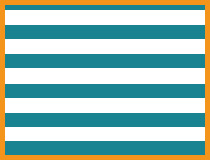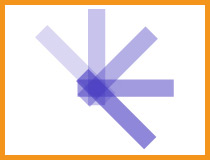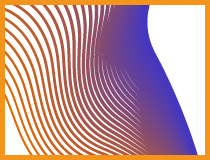In this blog, we will be discussing about, ‘Principles of Design’. They help in organizing various Elements of Design together to create an effective design.
You can also read a similar previous blog on ‘Laws of Design‘.
My name is Lalit M S Adhikari and we are at LTY. Let’s get started!
Table of Contents
Principles of Design
Principles of Design is a collection of various principles, namely, Balance, Emphasis, Movement, Pattern, Repetition, Proportion, Rhythm, Variety and Unity.

All these Principles of Design, act as rules or guidelines for arranging Elements of Design & creating a Good Design.
Related Topics:
Balance
Principle of Balance states that, “There should be equal distribution of visual weight”. When the Elements of Design are placed to weighted equally, they become more appealing.
Types of Balance
There are two approaches for achieving Balance in a Design:
- Symmetrical Balance
- Asymmetrical Balance
Symmetrical Balance
Symmetrical Balance includes designs with symmetry in them.
Symmetry could be attained in two ways:
- Pure Symmetry
- Approximate Symmetry
Pure Symmetry
In case of Pure Symmetry, as the name indicate, the design or artwork is symmetrical. It could be Lateral symmetry, Inverted symmetry or Radial Symmetry.
The symmetry is completed using same Elements of Design.

Related Topics:
Approximate Symmetry
In case of Approximate Symmetry, the symmetry is completed with similar Elements of Design and not necessarily same.

Asymmetrical Balance
In case of Asymmetrical Balance, the balance in design is attained through opposite or contrasting Elements of Design.

How to create Balance
Following steps could be taken to create Balance:
- Repeating a particular shape in regular intervals.
- Centering the biggest element in the document & placing other elements around it.
Related Topics:
Emphasis
Emphasis is focussing on a particular area to make it the centre of interest.

How to create Emphasis
Following steps could be taken to create Emphasis in Design:
- Create a centre of interest (focal point)
- Create a contrast between the primary element and it’s subordinates.
- Bring a sudden change in the direction, size, shape, texture, color, tone or line.
- Isolating an element in an image helps in creating emphasis.
Related Topics:
Movement
Movement can either be the actual motion or it can be implied by arranging parts of a design to create a sense of motion using lines or shapes (Elements of Design).

How to create Movement
Following steps could be taken to create Movement in Design:
- Use fuzzy lines (blurry or indistinct outlines)
- A change in the direction or in the light & shadows of an image can create a sense of motion.
- Connecting similar shapes with each other or overlapping them can create movement or restlessness.
- Using series of images as individual frames helps in producing a sense of movement.
- Repeating Geometric form creates optical illusion of movement, giving our eyes a wrong feeling of movement.
Related Topics:
Pattern
Pattern is repeating an object or a symbol (Elements of Design) all over an artwork.
Patterns are even named, sometimes, like Stripes and Zigzags etc.

Repetition
Repeating some aspect of the pattern throughout the design, unifies the total effect as well as the rhythm of the work.
It unifies you design together. It helps in gaining and retaining the viewer’s attention.
Elements of Design are used in a repetitively to form a particular format.
Although remember, avoid repeating an element so much that it becomes annoying to the viewer.

Related Topics:
Proportion
Proportion describes the harmony of the size, location or the amount of one element to the other element in the design.

How to create Proportion
Following steps could be taken to create right Proportion in Design:
- Place common elements together.
- In a design, create major and minor areas rather than having all equal parts. Equal parts may make the design monotonous and boring.
- Make sure the differences in size are great enough to keep them linked with each other.
- Arrange space in a subtle manner. Avoid dividing the composition into halves, quarter or thirds.
- Create harmony in the design.
Related Topics:
Rhythm
Rhythm in design refers to visual flow. It can be created by different Elements of Design by making the eyes move through the design.
It creates a sense of movement with a pattern and a texture.

The above painting instils a sense of movement with unique painting of cloud or wind which seems to move from left to right. The same style of shape is also used for the stars, moons and the overall color which gives a Rhythm to the whole painting.
Types of Rhythm
There are following three types of Rhythm based on the feeling they evoke:
- Regular Rhythm
- Progressive Rhythm
- Flowing Rhythm
Regular Rhythm

Progressive Rhythm

Flowing Rhythm

Related Topics:
Variety
Variety is mixing up the form, texture and color combinations to create an extra interest without giving up the simplicity of the design.
An artist or designer adds variety in an artwork or design:
- To gain and retain the viewer’s attention.
- To guide the viewer through the artwork or design.

How to create Variety
Following steps could be taken to create Variety in Design:
- Repeat a similar shape by changing the size, to add Variety and Unity at the same time.
- Retain the size of the Elements but change the color, to add Variety and Unity at the same time.
Unity
Unity is the brand of a Good Design. Unity is achieved when all the Elements of a Design, speak the same language.

How to create Unity
Following steps could be taken to create Unity in Design:
- Repeating colors, shapes, values, texture or lines creates a visual relationship between the elements.
- Tie all elements together by treating them equally. This creates an uninterrupted connection or union.
- Arrange shapes in a continuous linking format. This helps in creating a visual unity.
- Group related items together. This helps in presenting them as one cohesive group rather than a bunch of unrelated elements.
Related Topics:








